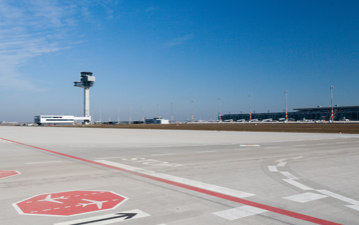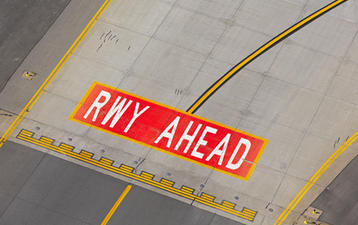Higher Code Letter aircraft operations at aerodromes
Aerodromes, including movement area and manoeuvring area – as well as associated facilities and equipment, are designed and operated in accordance to one or more “critical aircraft”, i.e. the aeroplane with the highest requirements that can use the airport.
According to ICAO Annex 14 Volume 1 – or national implementation thereof, as well as EASA regulations for Airports in Europe – each Aerodrome is assigned an “Aerodrome Reference Code”. As per 8th edition of Annex 14 such reference code is based on critical aircraft’s “Reference Field Length” (first code number) and aircraft wingspan (second code letter). For instance, an Aerodrome with a reference code 4E can accommodate aircraft with a “Reference Field Length” of 1800m and above and a wingspan up to 65m.
The reference code is however not a “strict limit” to airport and aircraft operators: an aerodrome or parts thereof may be used by aircraft with a Higher Code Letter than specified in its certificate. For example, aircraft types with code letter F such as Airbus A380, Antonov AN124 and Boeing B747-8F may use an Aerodrome with Aerodrome reference code 4E on a regular basis, subject to prior approval by the local authorities (CAA) and on the basis of a comprehensive safety assessment. The objective of such safety assessment is to evaluate the suitability of existing facilities and to determine the need for alternative measures, operational procedures and operating restrictions for the specific aeroplane concerned.
European requirements (Commission Regulation – EU – No 139/2014) are in this regard even more specific than in ICAO, and provide detailed Implementing Rules (IR), Alternative Means of Compliance (AMC) and Guidance Material (GM) about the general requirements regarding operations of Higher Code Letter aircraft as well as such assessment and its content. EASA also requires specifying Higher Code Letter aircraft in the terms of the Aerodrome certificate.
The main challenge of conducting such safety assessment lies in the number and complexity of the regulations and associated guidance material – as well as in their interpretation. Also, while some documents may contain good guidance – some requirements may be partially not in-line with more recent ICAO requirements as outdated (e.g. results of A380 Airport Compatibility Group – dated 2002, Boeing 747-8 Airport Compatibility Group – dated 2010). Such exercise is a lot of hard work that requires both diligence and a well-structured approach, to avoid making errors that could result in uncontrolled risks or unnecessary investment.
Another main challenge of such projects is to manage the cost of infrastructural measures required to achieve compliance: while safety is always a top priority, investment costs have to be balanced against the expected traffic and real safety benefits. For instance, upgrading a taxiway with shoulders on an entire 4000m straight segment to be compliant for an A380 requires a considerable investment. In case A380 operations are only planned as an occasional basis (e.g. emergency, diversion), operational solutions may be a more viable option.
A host of parameters and criteria needs to be assessed prior operating higher-code letter at aerodromes. airsight assists airports in the complex exercise, to ensure the safety of air operations is not compromised.
While an airport operator may conduct such safety assessment once or twice in its life time, such exercise is airsight’s “daily business”. airsight clients’ benefits of custom tools and re-useable checklists as well as previous experience in possible regulatory or operational solutions that may avoid very cost-intensive measures (e.g. enlargement of taxiways, extension of runway shoulders, relocation of runway holding positions).
airsight’s expertise covers all aspects involved in the process, including comprehensive compliance checks, aircraft movements and jet blast simulations, complex ILS interference risk modelling, ACN/PCN reviews, PAPI relocation studies, obstacle assessments, as well as the regulatory aspects related to airport certification.
Feel free to contact our <link 9 - internal-link "Opens internal link in current window">Airport Planning team</link> to discuss the challenges you may be facing, or visit our <link 3 - internal-link "Opens internal link in current window">training page</link> for courses related to airport safety, operations, planning and certification!
List of relevant regulations referenced in this article:
- AACG, Common Agreement Document of the A380 Airport Compatibility Group (AACG), Version 2.1, December 2002.
- ACI and The Boeing Company, Boeing 747-8 Airport Compatibility Group documentation including Common Agreement Document of October 2008, December 2010.
- EU, Commission Regulation (EU) No 139/2014 laying down requirements and administrative procedures related to Aerodromes pursuant to Regulation (EC) No 216/2008 of the European Parliament and of the Council, 12.02.2014.
- EASA, Acceptable Means of Compliance (AMC) and Guidance Material (GM) to Authority, Organisation and Operations Requirements for Aerodromes, Initial Issue, 27.02.2014.
- ICAO, Circular 301-AN/174, New Larger Aeroplanes - Infringement of Obstacle Free Zone: Operational Measures and Aeronautical Study, 2005.
- ICAO, Circular 305-AN/177, Operation of New Larger Aeroplanes at Existing Aerodromes, June 2004.
- ICAO, Circular 345-AN/203, New Larger Aeroplanes - Infringement of Obstacle Free Zone: Collision Risk Model and Aeronautical Study, Unedited Version 2016.
- ICAO, Doc 9774, Manual on Certification of Aerodromes, 2001.
- ICAO, Doc 9981, PANS Aerodromes, 2016.
- ICAO, Annex 14 Volume 1 – Aerodrome Design and Operations, 8th edition, July 2018
Key Facts



